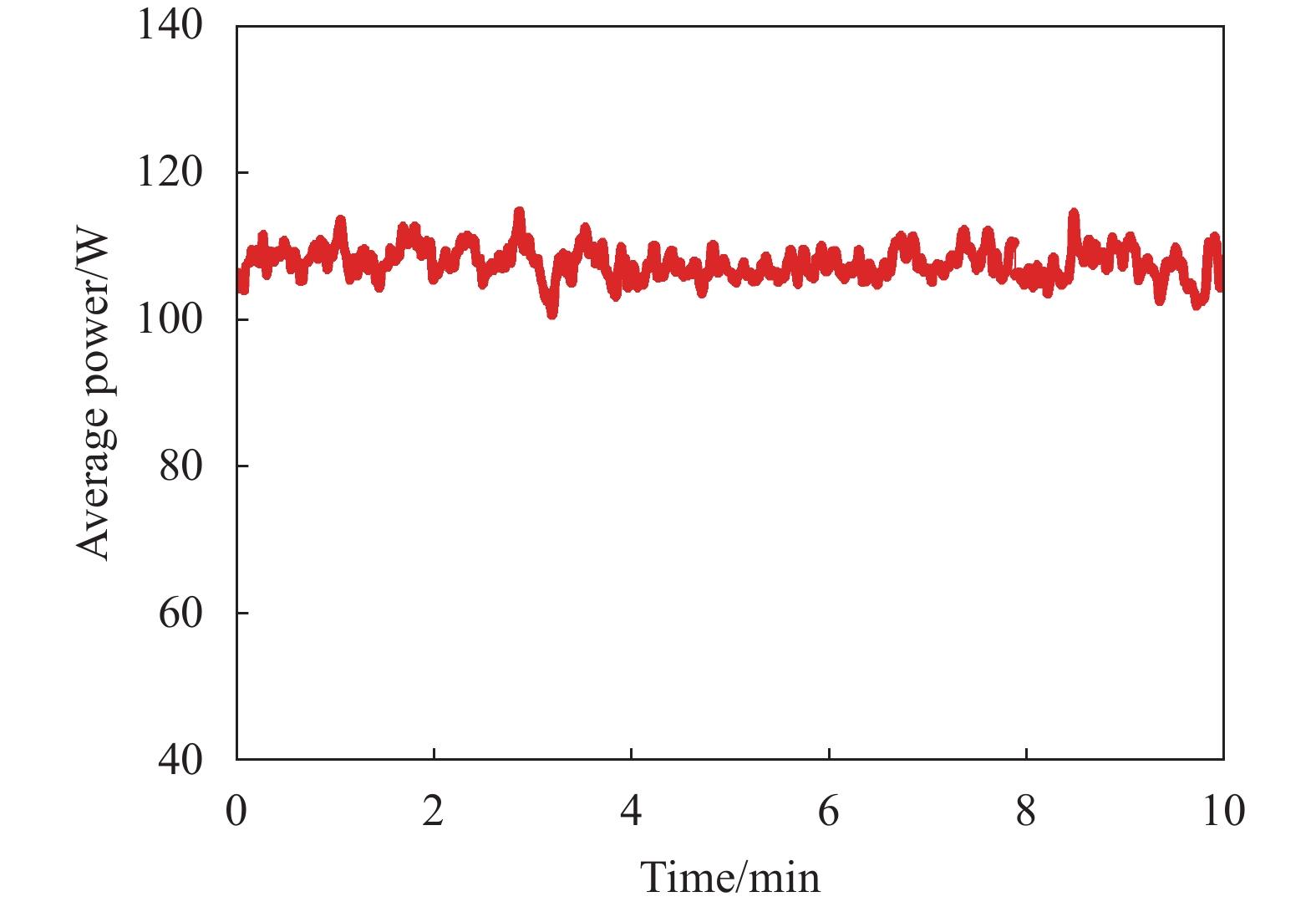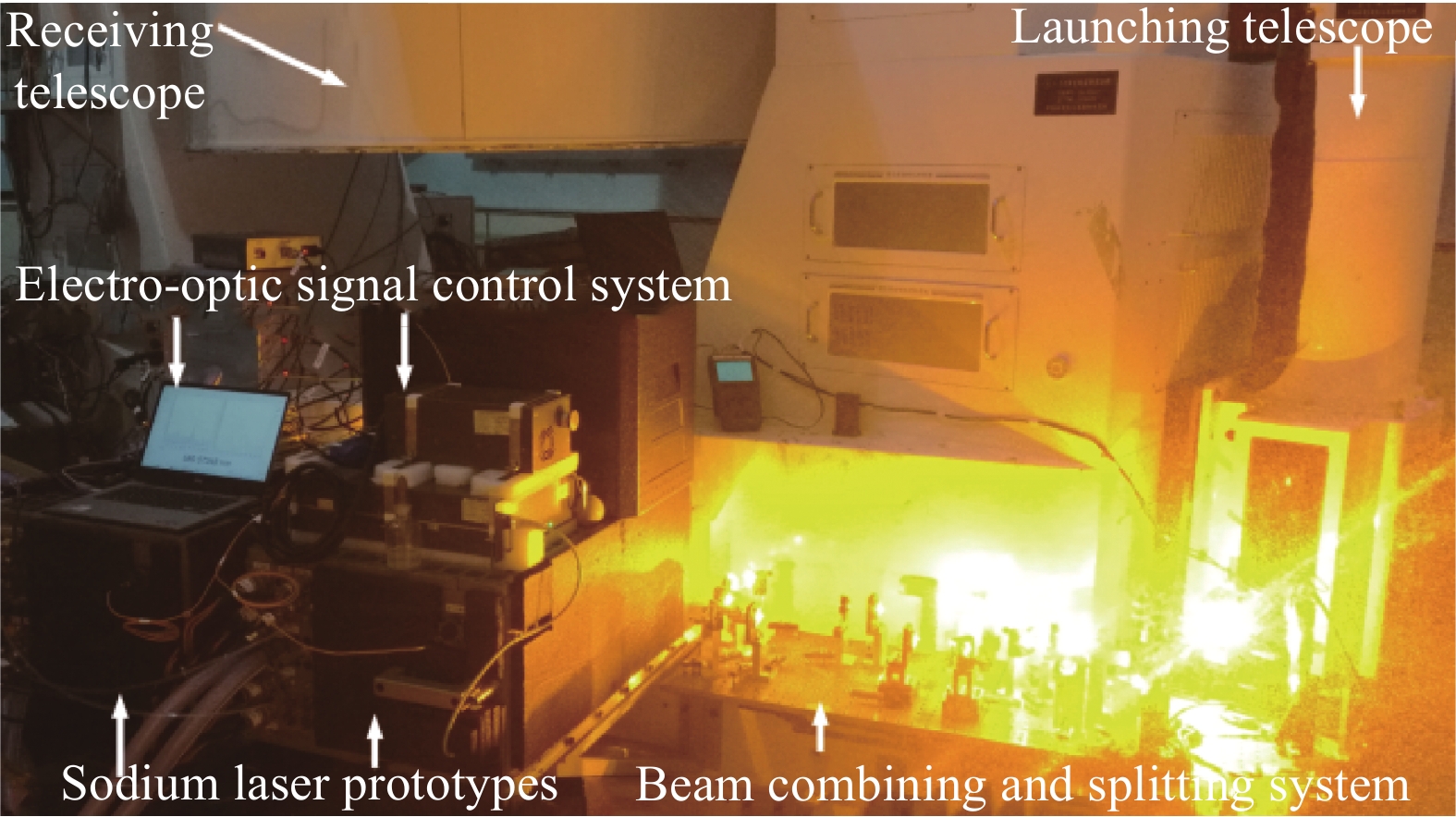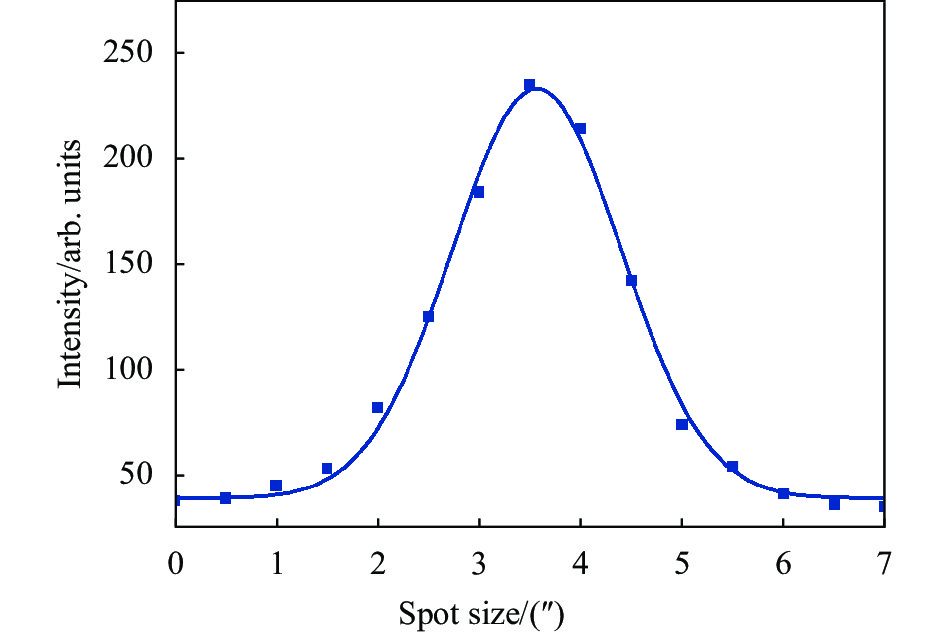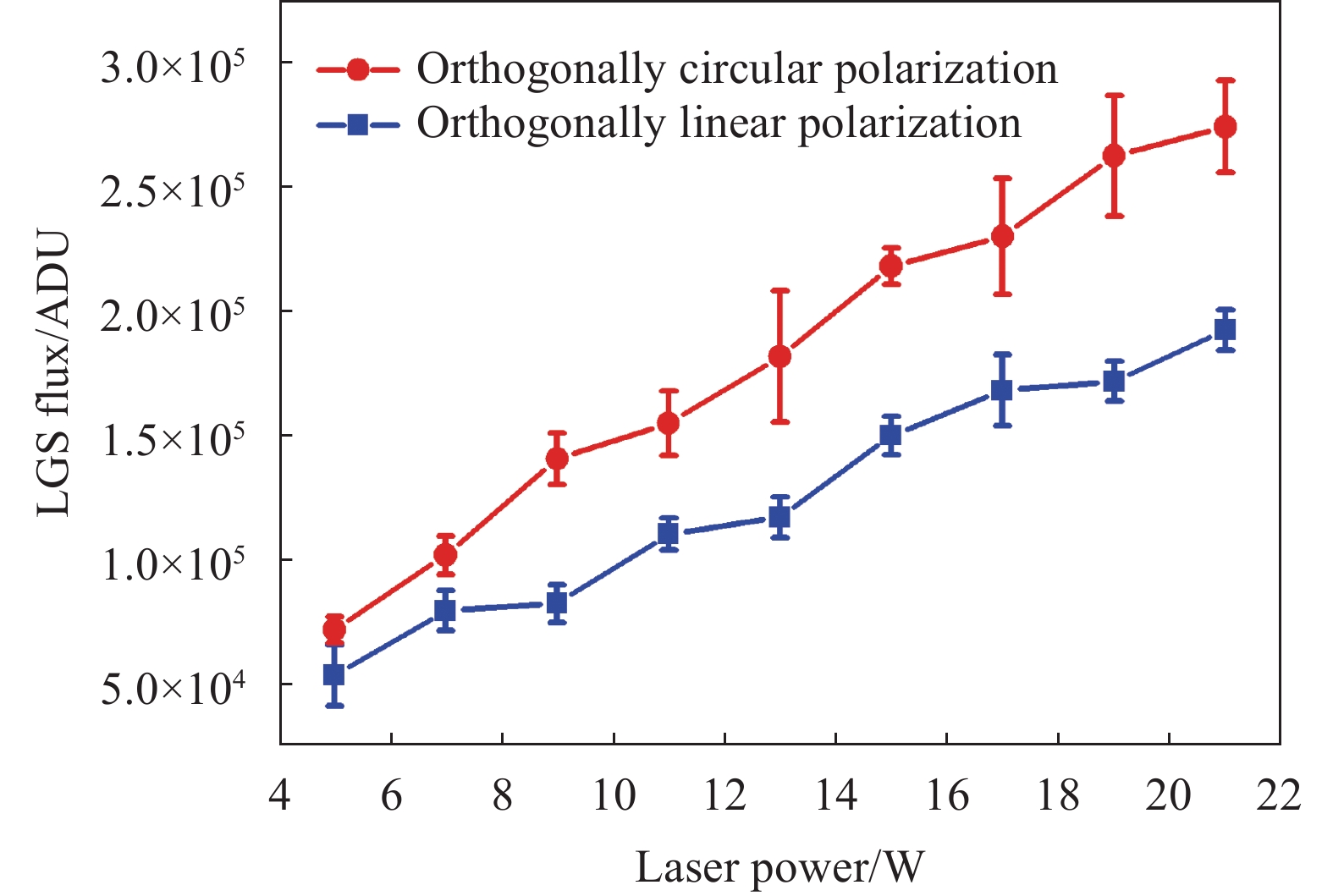-
钠导引星是利用特定波长为589 nm黄激光激发距地面90~110 km高空中钠原子发出共振荧光形成,它又被称为钠信标,用来导引自适应光学系统对大气湍流扰动导致的波前畸变进行校正,使光学/红外波段望远镜的分辨率达到近衍射极限[1-3]。目前,大多数天文望远镜都采用单层共轭自适应光学技术(Single conjugate adaptive optics, SCAO),只通过一个钠导引星探测波前畸变,再由一个变形镜快速补偿[4]。然而,由于钠导引星的生成高度有限以及钠导引星和待观测目标间的夹角而引入的非等晕误差,SCAO只能在一个较小的视场范围内获得清晰成像,限制了大口径望远镜的观测能力。为了实现更大视场内的高分辨率目标成像,在1989年提出了多层共轭自适应光学技术(Multi-conjugate adaptive optics, MCAO)[5],利用多束黄激光分别激发大气电离层钠原子产生多颗钠导引星,通过交叉探测补偿方法,使望远镜突破以上限制,多个变形镜可校正沿不同方向和不同高度的畸变信息,重构出大气湍流三维波前。
2012年,美国Gemini South天文台率先采用5颗10 W级连续波人造钠信标来补偿大气湍流的实验[6],高达80″的视场内,在近红外波段提供了近衍射极限的图像质量,成功验证了MCAO系统的优势。但在实际应用中发现,在采集钠导引星图像时受到来自低层大气的多束瑞利散射光柱影响,波前传感器上存在较大的残余噪声,成为激光导引星MCAO发展亟需解决的关键技术问题[7]。采用准连续脉冲钠导引星激光,通过时间/距离选通技术可去除瑞利散射干扰[7- 8],解决了星群系统中多光束串扰现象,从而提高自适应光学探测信噪比和整体性能。传统的纳秒、皮秒脉冲激光器具有较高的峰值功率,容易引起大气中间层钠原子的吸收饱和,从而降低回波效率;运转在微秒长脉冲机制的激光能够避免上述问题,是自适应光学系统的最佳选择。因此,欧洲8 m望远镜VLT、在建的国际30 m望远镜TMT、欧洲极大望远镜E-ELT等正在大力发展无串扰现象的微秒脉冲钠导引星星群技术。
文中介绍了准连续微秒脉冲钠导引星星群的研究进展情况。基于一种小角度精密偏振分光/并束调控技术,将4路20 W级/束、kHz重复频率、100 μs脉冲宽度的钠激光束由一台发射望远镜射向天空,实现了四颗无瑞利散射干扰的钠导引星星群,可获得高信噪比、高精度的波前畸变信息。与配备四个发射望远镜完成四束激光投射的ESO VLT系统相比[9],这种方法提供了更高的可靠性、更好的灵活性、更低的成本和更简单的部署,为发展大型天文望远镜的多导星自适应光学系统开辟了新道路。
-
激光钠导引星星群天空测试的总体实验布局见图1,主要包括钠信标激光系统、发射和接收望远镜系统。其中,发射望远镜由直径300 mm的主镜和直径20 mm的次镜组成,接收望远镜的有效口径为1.8 m,并在库德焦平面安装一个CCD对激光钠导引星成像,具体参数已经在之前发表的文章中描述[10]。100 W级钠激光采用了重复频率为500 Hz的两台50 W级脉冲钠激光源1和钠激光源2的时序偏振合成方案[11]。为采用一台发射望远镜发射多束激光束,设计了一种小角度精确偏振合束和分光的方法。

Figure 1. Experimental configuration of multiple sodium LGS system (BS, beam shaper; HW, half-wave plate; HR, high reflection mirror; P, thin film polarizer; QWP, quarter-wave plate; PD, photo detector; OC, optical chopper; CCD, charge-coupled device; p, horizontal polarization; s, vertical polarization; Ll/Lr, linearly polarization at a 135°/45° to the x-axis; Cl/Cr, left-hand/right-hand circular polarization)
首先,钠激光源1和钠激光源2输出激光束经各自的光束整形器BS扩束并准直为光斑大小8 mm平行光,再分别通过半波片HW-1和HW-2将其偏振态调整为竖直方向(s偏振)和水平方向(p偏振)。正交偏振的两束激光通过具有s偏振光高反、p偏振光高透特性的偏振合成器P1实现偏振非相干合成,合成效率高达96%,合成后的光束有一定间隔,光束质量保持不变;与相干合成方法相比,该技术具有结构简单、稳定好、效率高的优势,光束间互不影响,且整个系统无需复杂的相位控制机制。半波片HW1/HW2和偏振器P1组合作为功率衰减器来分别控制两路激光束的出射功率,而剩余光束则注入到通水冷却的光收集器内。将半波片HW3放置在偏振器P1的后面,每一束激光经过HW3后偏振方向将发生改变,再由偏振分束器P2分成两束;其中,垂直分量被P2反射,水平分量则透过P2后,经高反镜HR2和HR3反射后再次透过P2,可以通过旋转HW3主轴与x轴之间的角度来调节光束间的能量比。最后,四束直径为8 mm的部分重叠黄色激光束被高反镜HR4反射注入到口径20 mm的次镜,然后被主镜准直成300 mm发射到天空。采用压电陶瓷促动器精确改变高反镜HR1、HR2、HR3和HR4的放置角度和位置,优化四束激光束光轴间的夹角和分开距离,以满足不同的应用需求。当然,如果使用更高功率的钠信标激光器,采用n个半波片和偏振器的组合,可以在有限空间内获得2n束激光束的分光。
为了进一步提升钠导引星的回波流量,在发射望远镜前插入一个1/4波片QWP,将s偏振光和p偏振光调整为圆偏振态,以获得钠原子高效率抽运。采用多通道的脉冲同步触发和延时器分别控制钠激光器1和激光器2,通过放置在高反镜HR2后的光电探测器PD记录合成光束的脉冲特性,以精密优化两台激光器的触发时间。此外,在CCD前安装有一个特制的光学斩波器OC,通过对所监测到的激光脉冲特征和所探测到的钠导引星图像的闭环反馈,来精确控制OC的工作状态,只允许钠导引星回波信号通过,遮挡瑞利散射光。
-
钠信标激光器在最佳状态下工作,输出功率最高,波长锁定在钠D2a吸收线。测得10 min钠导引星激光输出平均功率为106 W,功率波动为±2.1%,如图2所示。图3为采用WS-7波长计监测输出激光中心波长为589.15913 nm,稳定性优于±0.23 pm,线宽小于0.3 pm,对应频率稳定性±0.2 GHz和线宽0.26 GHz。图4为采用光电探头监测到的589 nm激光的脉冲轨迹。两台钠信标激光器分别运转在500 Hz,单脉冲宽度约100 μs,如图4(a)和(b)所示,钠信标激光器1相对于钠信标激光器2的触发时间延迟1000 μs;图4(c)给出了合束激光的脉冲序列结果,可以看到重复频率为1 kHz,相邻的两个激光脉冲是独立的,呈现出正交的s/p偏振态。同时,百微秒脉冲宽度可以更高效地激发钠原子,kHz的高重复频率也有利于校正大气的高阶像差。
-
2021年1月,中国科学院理化所与光电所、国家天文台合作,于云南丽江1.8 m望远镜上进行激光钠导引星星群实验研究。如图5所示,发射望远镜安装在接收望远镜的一侧,两台50 W级脉冲钠激光器、偏振合束和分光系统及光电信号控制系统固定在发射望远镜附近的殷钢底板上。除了较长的光束整形部分外,偏振合束和分光部分非常紧凑,所占面积仅为0.07 m2 (长0.35 m,宽0.2 m)。测量望远镜的透过率约89%,激光经过整形透镜、若干高反镜及偏振合成/分光过程传输效率约91%,故从光束整形器到发射望远镜出射窗口的功率损耗约20%。
在地面时,由于四束黄色光束之间的距离和角度较小,看似一束光斑直径较大的激光束,但发射到大气中间钠层后四束激光完全能分开,并分别激发钠原子获得高亮度的钠导引星。图6为CCD 捕捉到的激光钠导引星成像,在一个40″的正方形星座上有一个独立的4颗星点分布,通过控制压电陶瓷促动器调节分光反射镜与x轴的夹角,可使单颗导星沿水平方向分开,调节与y轴的夹角,可使单颗导星沿竖直方向分开,在两个方向上不同角度的组合使得星群构型可变为线形、平行四边形和菱形等。如果使用一个更大口径的发射望远镜,可实现几角分的更大观测视场。实验结果表明,采用小角度精确偏振合束和分光的方法为多导星星群的研制提供了一种新方法,能够只通过一个发射望远镜来实现多导引星星群。
考虑到成像系统像差、激光光束质量及大气视宁度的限制,通过调焦使激光束在天空中产生的钠导引星最小光斑尺寸约为3.25″,如图7所示,拟合曲线表明钠层处的导引星光斑强度呈高斯分布。根据理论分析和实验研究,相比于线性偏振激光,圆偏振光激发钠原子时会形成光学泵浦效应,周期性地将钠原子往更高的磁量子数泵浦,极大地提高原子使用率,从而提高激光器的耦合效率和回光流量[12]。然而,偏振时序合成技术使发射的脉冲激光呈交替的s/p偏振态,通过调节四分之一波片的角度无法产生一致的左旋圆偏振光或右旋圆偏振光。测量了正交的线偏振态和正交的圆偏振态情况下,单颗激光钠导引星光子数流量随发射激光功率的变化,结果如图8所示,在最大输出功率下,正交圆偏振光比正交线性偏振光对钠原子的激发效率提高了约45%,这与之前左旋/右旋圆偏振光测试结果符合的很好[13-14],表明正交圆偏振激光与圆偏振光一样可以高效抽运钠原子。根据回光流量和天体星等之间的关系,估算单颗激光导引星亮度约为V波段8等星。
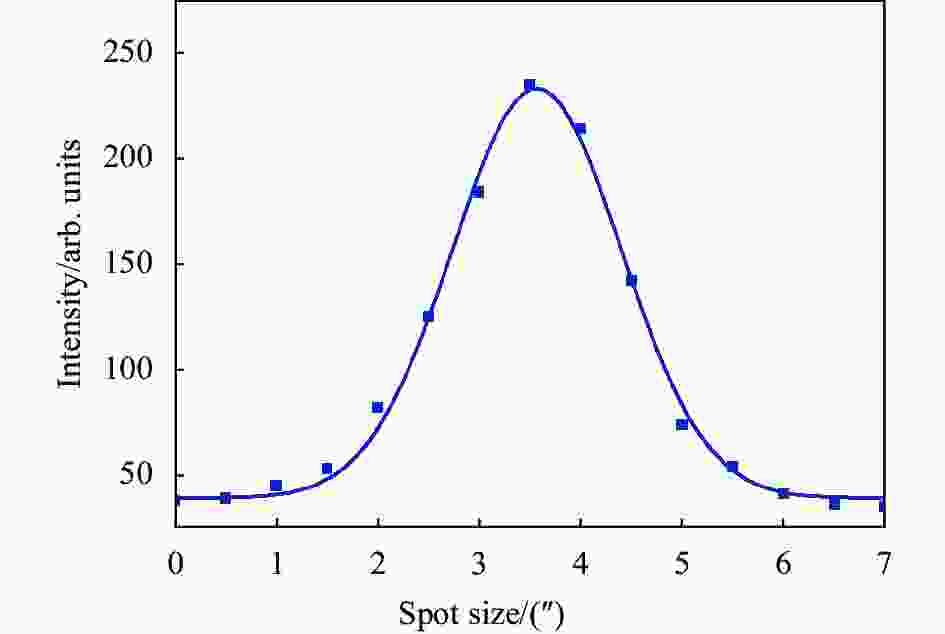
Figure 7. Spot size of single sodium LGS(Squares: Experimental results; Solid line: Gaussian fitting)

Figure 8. LGS flux for orthogonally circular and orthogonally linear polarization versus laser power
从图6可以看出,在激光钠导引星星群附近具有多束较高亮度的瑞利散射光柱,其强度比钠导引星信号强约三个量级,这大大降低了探测信噪比,成为多层共轭自适应光学系统的一个关键问题。与连续波模式激光相比,准连续脉冲激光可以利用由生成高度不同导致的回波时间差来消除瑞利散射光。根据钠激光器的重复频率1 kHz和脉冲宽度100 μs,理论模拟的瑞利光与钠导引星回波信号如图9所示。可以看到,由第一个激光脉冲所产生的第一个瑞利散射光从0~433 μs返回到地面,所产生的第一个钠导引星回波时间为533~833 μs;由第二个激光脉冲所产生的第二个瑞利散射光从1000~1433 μs返回到地面,在第二个钠导引星回波时间(1533~1833 μs)之前和第一个钠导引星回波时间(533~833 μs)之后,时间上没有重叠。因此,通过控制斩波器运转与探测到的钠导星回波同步,可阻断瑞利散射光进入到CCD,又不影响接收钠导星的光子数流量,如图9中插图所示,探测信噪比显著增强三四倍,便于后续自适应光学系统闭环工作。
-
随着地基望远镜的口径越造越大,为满足高分辨率、高灵敏度、大视场的天文观测需求,发展激光钠导引星星群技术是关键。文中采用一种小角度精密偏振分光/并束调控方法,在丽江天文台1.8 m望远镜上,通过一台发射望远镜产生了微秒脉冲激光钠导引星星群,在40″观测视场内实现了构型可调控的四颗导引星,如线形、平行四边形、菱形、正方形等,每颗星亮度约8等星,光斑大小约3.25″。实验中,将激光的正交线性偏振态转化为正交圆偏振态后,由于光学泵浦作用,激发效率提高了1.5倍左右。此外,通过脉冲同步控制技术成功去除了瑞利散射对钠导引星光斑的污染,可获得高信噪比波前探测,提高对观测目标的成像质量,这一结果将有助于推动大型地基光学望远镜中MCAO技术的发展。
Technology of microsecond-pulse sodium laser guide stars asterism (Invited)
doi: 10.3788/IRLA20220321
- Received Date: 2022-05-09
- Rev Recd Date: 2022-06-02
- Accepted Date: 2022-06-06
- Publish Date: 2022-07-05
-
Key words:
- sodium laser guide star /
- sodium laser guide stars asterism /
- microsecond pulsed laser /
- polarized modulation /
- multi-conjugate adaptive optics
Abstract: Sodium laser guide stars (LGS), known as artificial stars, can be used to detect and correct wavefront aberrations induced by atmospheric turbulence, which can significantly improve the adaptive-optical telescope's imaging quality. Due to the limited corrected field of view of single LGS, multiple sodium LGS, created by exciting sodium atoms in the Earth's mesosphere via multiple yellow laser beams, is developed to yield high-resolution imaging in a much larger field-of-view, which has important applications in the fields of precision astronomical observation and space target detection. The successful implementation of microsecond-pulse sodium guidestars constellation via 100 W level pulsed sodium laser was reported, based on a small angle precise polarized combining and splitting technology. At Lijiang Observatory, four-ways~20 W/beam yellow laser beam with kHz repetition-rate and hundred-μs pulse width were projected up to the sky through one launching telescope, and generated a distinctive four-point grouping on a 40" field of view with variable configurations of linear, parallelogram, rhomboid and square. The spot size of each guide star was about 3.25" and the corresponding brightness was around 8 magnitude in V band. The sodium return signal could well avoid Rayleigh light interference by the pulse synchro controlling technology to deliver higher spatial resolution. This could serve as a technical reference for multi-conjugate correction systems on large-aperture astronomical telescopes.



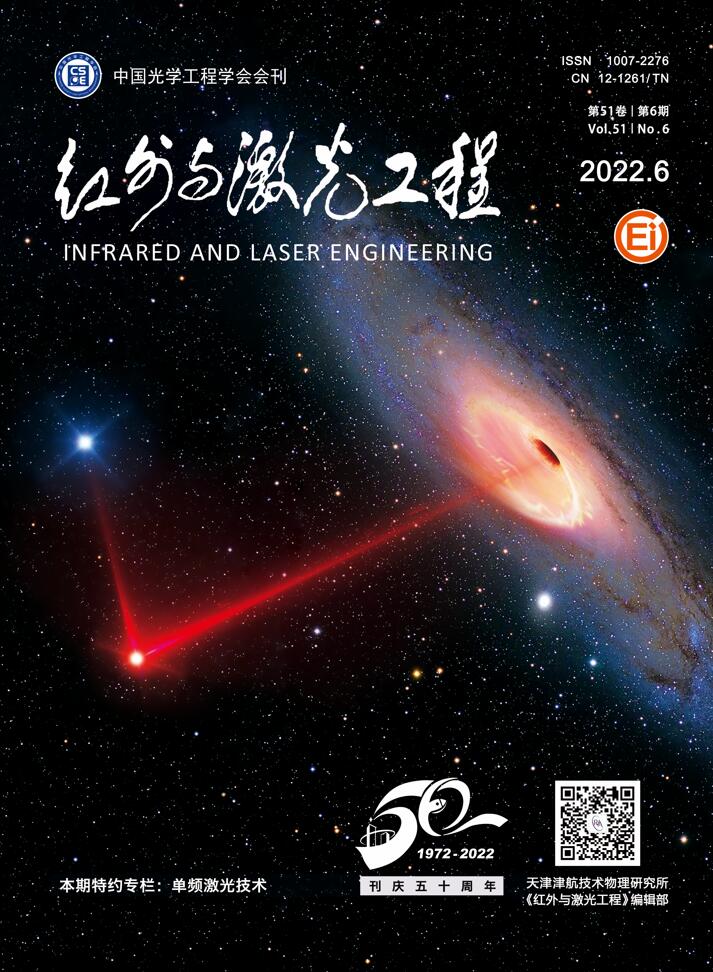












 DownLoad:
DownLoad:
